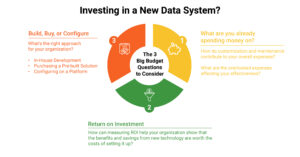This post originally appeared on the SurveyCTO blog and is republished with permission.

We recently caught up with Taylor Downs, founder of OpenFn and co-founder of Vera Solutions, to learn more about how he’s helping international organizations harness data for social impact, his recommendations for creating dashboards, and some of the cool automations available to SurveyCTO users.
Tell us a little about yourself and OpenFn.
My first job out of college was with an HIV-prevention organization based in South Africa. I worked in over a dozen countries across southern and eastern Africa, helping implementing organizations adapt our behavior-change curriculum to their varying local contexts.
During this time, Zak Kaufman, Karti Subramanian, and I identified a major need—not just for our organization, or the HIV-prevention space, but for the “international development” sector more broadly. Many organizations were hamstrung by their lack of access to good information. Specifically, they didn’t have high quality data systems, but instead relied on paper and Excel, introducing inefficiency through huge lag-times from data capture to analysis and the chance for degradation as too many rote tasks were being carried out by human beings.
We started Vera Solutions to address this issue, and have been designing and implementing data systems for impact-first organizations since 2010. We’ve worked with 179 different organizations and have systems live in 45 countries. Our consultants have logged 87,000 hours in service of partners like Innovations for Poverty Action, J-PAL, PATH, PSI, Population Council, and many more.
At the end of 2014, we identified another, more specific gap in the ICT4D landscape. While there are lots of great technologies out there, the process of building an end-to-end, robust, integrated system making use of multiple technologies was still too difficult. We spun out OpenFn to address this issue.

“When data is captured on SurveyCTO, you could trigger SMS alerts to thank respondents, visualize those data on a beautiful map in real-time, or even set up logic to instantly pay an enumerator via Mobile money if all questions are filled in properly on the survey!”
OpenFn is designed to give even small organizations the ability to run an enterprise-grade integration platform (connecting all of their technologies exactly how they want to) without paying $3000-$5000/month with a full year-contract! Tools like Zapier and IFTTT accomplish repeat migration tasks with ease, and Jitterbit, Mulesoft, and Informatica have comprehensive, corporate integration tools designed to be used by large IT teams. OpenFn hopes to find the middle-ground, helping development organizations run truly cutting-edge systems without staffing to the gills and spending a fortune.
How can SurveyCTO users take advantage of OpenFn in their work?
OpenFn allows SurveyCTO users to connect their data to countless other applications, including DHIS2, Salesforce, Carto, Zoho Reports, and even SMS or mobile payment applications. When data is captured on SurveyCTO, you could trigger SMS alerts to thank respondents, visualize those data on a beautiful map in real-time, or even set up logic to instantly pay an enumerator via Mobile money if all questions are filled in properly on the survey!
What features are you working on now?
Right now we’re working on simplifying the interface as much as possible without taking away the flexibility that has drawn users to OpenFn in the first place. It’s an interesting challenge, and we recognize that the simplicity of our first product (which only connected ODK and SurveyCTO to Salesforce) was made possible by its narrow focus.
A big advantage of OpenFn is the ability to store data for editing and reprocessing if a transaction fails. Say, for example, that a GPS field was missing during data collection and the SurveyCTO form submission gets rejected from your map on Carto. You’d receive an email from OpenFn and would be able to manually code the GPS location before retrying the run. Our users are asking for an easier to use error-handling interface that displays any error messages next to the initial payload for editing.
Many of our users have been asking about dashboards for monitoring. Do you have any recommendations?

Zoho Reports and Salesforce are the most commonly used by our clients. More recently I’ve been playing around with Metabase and Re:dash. They’re great because they are open-source and let users who understand SQL create beautiful dashboards very quickly. At OpenFn, we run our own internal dashboards for monitoring on Re:dash. Using Google Compute the whole thing costs us about $4/month. It’s great, especially considering the costs of other tools.
“With the advent of platforms like OpenFn, the cost of getting a really sophisticated integrated system up and running has decreased drastically, but our software can’t solve what’s really the thorniest problem: the non-technical stuff.”
One of the services we’ve started providing alongside our integration platform is data-warehouse and dashboard setup. Using OpenFn, we can connect lots of different data sources to a central data warehouse for our clients, then plug in and set up one of these free visualization/dashboard tools in a matter of days. It’s very exciting to be able to unlock a client’s data for analysis so quickly.
Any advice for SurveyCTO users who are trying to integrate systems or harness technology (rather than being overwhelmed by it)?
In the past, integration presented a huge challenge both in terms of tech/resources required and in terms of system design/communication. With the advent of platforms like OpenFn, the cost of getting a really sophisticated integrated system up and running has decreased drastically, but our software can’t solve what’s really the thorniest problem: the non-technical stuff.
Before approaching a provider like OpenFn, clients would do well to spend as much time and money as possible understanding their various users and clearly articulating what, why, and how information is being captured and moved around the organization. Once these questions are answered and an organization can make a strong case for crystallizing and automating some of these processes, working with OpenFn or another technology will be fairly easy.







